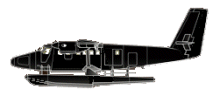Incident Overview

Description
The float-equipped DHC-6-300 aircraft, registration 8Q-TAQ, suffered a bounced landing and wing tip strike accident at Vommuli Water Aerodrome, Maldives. The flight to Vomuli was uneventful until the initial touch down on water. The crew did a circuit to conduct a visual check of the landing area and then decided to land parallel to the waves and continued the approach. The PIC estimated the wind was from 280ø at a speed of approximately 10 knots. During landing, the aircraft impacted a swell, resulting in a bounce that led to the left-hand wing drop and the wing contacting with the water. Immediately after the aircraft came to a stop, the crew checked for any damages and found the left-hand wing was damaged. Causes / Contributing Factors The AICC determines that the probable causes of the accident were: 1. The aircraft inadvertently hit a swell during landing. 2. Limited experience of the PF to operate to Category C water aerodromes. 3. Complacency and lack of vigilance on the part of PM to closely monitor the situation and take over when necessary. 4. Non-conducive power management for the aircraft behaviour during a bounce.
Primary Cause
The aircraft inadvertently hit a swell during landing.The aircraft inadvertently hit a swell during landing.Share on:

